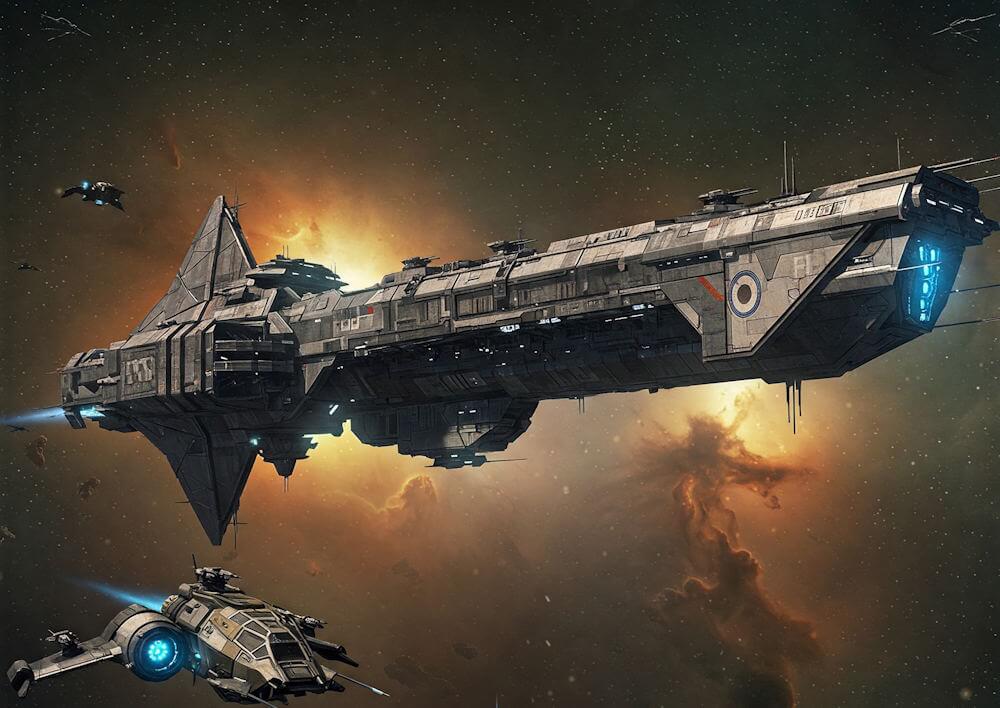Homeworld 3 marks a significant return to the beloved franchise that has been a hallmark of the real-time strategy (RTS) genre, especially within the context of space-themed gaming. Developed by a passionate team of creators who were instrumental in shaping the original titles, Homeworld 3 is positioned to rekindle the awe and tactical depth that fans have cherished since the franchise’s inception in the late 1990s. The game is set for release on [insert specific date], after a prolonged period of anticipation and speculative discussions following the last full installment of the series.
The legacy of Homeworld is profound; it pioneered 3D real-time strategy gaming by allowing players to command vast fleets of starships in three-dimensional space. Its critical acclaim established a benchmark for storytelling and visual presentation in RTS games, creating a loyal fanbase that eagerly awaits the next installment. Fans have been vocal about their desires for renewed exploration of the series’ complex narrative and intricate gameplay mechanics, which set a high bar for future entries. Homeworld 3 promises to uphold the traditions of its predecessors while integrating modern gameplay advancements that cater to both seasoned players and newcomers.
The anticipation surrounding Homeworld 3 is further amplified by the emergence of advanced gaming technologies, such as enhanced graphics and improved AI systems, which can add depth and realism to the gameplay experience. As players navigate the delicate balance between strategic resource management and tactical combat, they will once again immerse themselves in the richly crafted universe that the Homeworld series is known for. The resurgence of interest in the franchise speaks to its significance within the RTS genre, setting the stage for what many hope will be a triumphant and groundbreaking return to form.
A Brief History of the Homeworld Series
The Homeworld series, launched in 1999 by Relic Entertainment, is a pivotal franchise in the realm of real-time strategy (RTS) games, particularly within the space genre. The original title, Homeworld, showcased revolutionary fully 3D graphics and a compelling narrative centered around a race seeking their home planet. This innovative approach to gameplay not only captivated players but also set a high standard for subsequent RTS titles.
Following the success of the first game, Homeworld: Cataclysm was released in 2000. This standalone expansion introduced a new storyline, focusing on the conflict arising after the events of the original game. Cataclysm built upon its predecessor’s gameplay mechanics, further enhancing the strategic depth and variety through the introduction of new ships, technologies, and an engaging campaign. The narrative continued to evolve, expanding the universe and deepening the lore, which has become a hallmark of the series.
Years later, the franchise was revitalized with the release of remastered versions of both Homeworld and Homeworld 2 in 2015. These remastered editions not only modernized the graphics with enhanced textures and effects but also improved audio design and user interfaces, appealing to both veterans and newcomers alike. The remaster preserved the original storylines while providing a polished experience, reinforcing the series’ iconic status in the gaming community.
Through its journey, the Homeworld series has evolved significantly, adapting to the advancements in technology and player expectations. The combination of innovative gameplay, rich storytelling, and stunning visuals has established it as a cornerstone of space RTS gaming. With the anticipated release of Homeworld 3, fans and newcomers alike are eager to see how the franchise continues to develop its legacy.
Gameplay Mechanics of Homeworld 3
The gameplay mechanics of Homeworld 3 prominently feature strategic elements that set it apart from both its predecessors and the broader real-time strategy (RTS) genre. Upon entering the immersive universe of Homeworld 3, players are tasked with managing expansive fleets, navigating intricate battlefields, and employing tactical maneuvers. Fleet management is a central component, where players must assemble and command diverse ships to optimize their strategies. Each ship type boasts unique capabilities, from agile interceptors designed for quick assaults to massive capital ships that serve as formidable artillery platforms. This variety enables players to engage in complex tactical planning, promoting dynamic gameplay experiences.
Resource gathering in Homeworld 3 plays an essential role in sustaining fleet operations and enhancing ship capabilities. Players are required to strategically collect resources, which are vital for constructing new vessels and upgrading existing ones. This mechanic demands foresight and adaptability, as players must balance exploration of resource-rich areas with the need for robust defense against enemy threats. Furthermore, the game introduces new resource types and gathering mechanics that supersede previous iterations, challenging players to rethink their approaches to managing their economies and fleets.
In terms of battle tactics, Homeworld 3 encourages players to adopt innovative strategies to outmaneuver opponents. Utilizing the three-dimensional space environment, players can conduct flanking maneuvers and employ ambush tactics, making spatial awareness critical for victory. The game also incorporates enhanced AI, which adapts to player strategies, prompting enthusiasts to remain versatile in their approach. When juxtaposed with earlier installments in the Homeworld series and contemporary RTS titles, these mechanics not only elevate the gameplay but also reinforce the uniqueness inherent in the Homeworld franchise, solidifying Homeworld 3’s position within the competitive RTS landscape.
Visual and Audio Presentation
In the realm of real-time strategy games, the visual and audio presentation plays a crucial role in shaping the player’s experience. Homeworld 3 sets a new benchmark in this regard, utilizing an advanced graphics engine that brings the vastness of space to life with remarkable detail. The art style marries realism with a distinctive aesthetic, creating environments that are not only visually stunning but also thematically coherent with the game’s narrative. Players can expect to see intricately designed starships and celestial bodies, as well as fluid animations that enhance the immersion within the game.
The graphics engine behind Homeworld 3 is a significant upgrade from its predecessors, providing high-resolution textures and advanced lighting effects that cast realistic shadows and reflections. The game effectively combines vibrant colors with darker tones, emphasizing the vast, often ominous, void of space. This meticulous attention to detail not only elevates the gameplay experience but also enriches the storytelling aspect, allowing players to feel the weight of their missions and the stakes involved.
Sound design is equally integral to the immersive experience in Homeworld 3. The game features an orchestra-driven score that captures the grandeur and tension of space combat. Each piece of music is expertly composed to reflect the mood of different gameplay scenarios, enhancing emotional engagement. Coupled with high-quality sound effects—from the subtle hum of starship engines to the explosive sounds of battle—Homeworld 3 ensures that players are not merely passive observers but active participants in an epic saga.
Ultimately, the visual and audio presentation in Homeworld 3 showcases the advancements in game design and technology that have come to define modern space RTS titles. By harmoniously integrating graphics and sound, Homeworld 3 successfully creates an engaging atmosphere that resonates with players, drawing them deeper into its richly crafted universe.
Narrative and World-Building
The narrative structure of Homeworld 3 serves as a significant pillar, intricately weaving together the tapestry of storylines and character arcs that fans have come to cherish. Set in a universe rich with history, the game deepens the lore established in previous installments while introducing new characters and conflicts that drive the plot forward. This continuation fosters a sense of familiarity while simultaneously inviting players to explore new dimensions of the Homeworld mythos.
Central to the story is the development of hero and antagonist characters, who experience growth and change throughout the game. Players are reintroduced to beloved figures from past installations, while fresh faces emerge to challenge the established order. The tension between these new characters and the existing ones creates dynamic interactions, enriching the narrative and offering opportunities for interesting character development. This evolution is critical in a space real-time strategy (RTS) game, as it allows for deeper emotional engagement and enhances the player’s investment in the story.
Moreover, Homeworld 3 adeptly balances continuity and innovation, ensuring that it feels like a natural progression of the universe rather than a disjointed spin-off. It meticulously retains key elements of the established lore, allowing veterans of the franchise to appreciate the nods to past events while new players can still find accessibility in the narrative. The game delves into themes of survival, legacy, and conflict, which resonate deeply within the larger context of the Homeworld saga, making the player experience both nostalgic and fresh.
Through its carefully crafted narrative and world-building, Homeworld 3 establishes itself as a significant addition to the RTS genre, capturing the essence of what fans have come to expect while ambitiously expanding the boundaries of the universe.
Community Reception and Critiques
The release of Homeworld 3 has sparked extensive discussion within the gaming community, with players expressing a mixture of enthusiasm and critique. Reviewing the game across various platforms, the general reception has been largely positive, with many praising its stunning graphics and adherence to the lore established in earlier iterations of the Homeworld series. The game effectively captures the essence of space real-time strategy (RTS), fostering a sense of nostalgia among longtime fans while integrating modern gameplay mechanics that appeal to new players.
Players have noted the innovative ship designs and dynamic combat mechanics as a standout feature. The addition of new gameplay elements, including advanced tactical options and AI behavior, has been highlighted as a significant enhancement over prior titles. Many users appreciate how these changes contribute to making battles feel more engaging and strategic, ultimately elevating the overall experience. This sense of immersion is further enhanced by the game’s soundtrack, which mirrors the epic tone often associated with space exploration narratives.
However, the reception has not been entirely favorable. Critics have pointed out several issues, particularly concerning gameplay balance and performance optimization. Some players have experienced technical difficulties, including bugs and glitches that hamper gameplay. Moreover, a portion of the player base feels that certain aspects of the game, such as the user interface and tutorial systems, could benefit from refinement to facilitate easier navigation and understanding.
In terms of community feedback, forums and social media platforms reflect a strong desire for ongoing support and updates from the developers to address these concerns. Overall, while Homeworld 3 has garnered considerable praise for its artistic achievements and new features, its success is tempered by the need for improvement in certain areas to fulfill the community’s expectations fully. The ongoing dialogue amongst players will undoubtedly shape the future of the franchise as it evolves.
Comparative Analysis with Other RTS Games
In the realm of real-time strategy (RTS) games, particularly those set in space, a careful comparative analysis is essential to understand where Homeworld 3 stands in relation to its contemporaries. Renowned for its innovative gameplay and storytelling, the Homeworld franchise has long been a pivotal element in the RTS genre. This latest installment, Homeworld 3, brings forth advancements that seek to enhance both player engagement and strategic complexity, yet it must be assessed against other significant titles to truly gauge its impact.
Examining classics like StarCraft II and the Sins of a Solar Empire reveals both similarities and divergences that define the space RTS experience. StarCraft II, for instance, is celebrated for its competitive multiplayer environment, offering players an intricate balance of unit design and resource management. In contrast, Homeworld 3 emphasizes three-dimensional movement across vast spaces, which can create a more immersive and visually striking experience. This significant focus on verticality and spatial tactics differentiates it from traditional flat battlefield setups seen in many RTS formats.
While Homeworld 3 aspires to innovate, it must also tackle the complexity seen in recent entries like the critically acclaimed Stellaris. The latter introduces intricate diplomacy, resource gathering, and exploration mechanics, appealing to players who appreciate depth in strategic options. Homeworld 3, while exhibiting a compelling narrative and strong lore, needs to ensure that its systems do not overwhelm players new to the genre. Therefore, the game’s design philosophy aims to balance accessibility with depth, eliciting a broader player engagement.
Ultimately, the effectiveness of Homeworld 3 can be seen through its ability to modernize established mechanics alongside its intrinsic gameplay innovations. By analyzing these elements in conjunction with the successes and challenges posed by other RTS games, one may more accurately assess the potential of Homeworld 3 to meet or exceed the high standards set by its predecessors and competitors alike.
Future of the Homeworld Franchise
With the anticipated release of Homeworld 3, discussions surrounding the potential future of the Homeworld franchise are at an all-time high. As one of the most celebrated real-time strategy (RTS) series, Homeworld has left an indelible mark on the genre, paving the way for innovations in gameplay mechanics and storytelling within space-based gaming environments. The success of Homeworld 3 could very well dictate the trajectory of the franchise in the coming years.
Following the release of Homeworld 3, fans are eager to witness the introduction of expansions that may delve deeper into the rich lore of the Homeworld universe. Potential expansions might introduce new factions, campaigns, and gameplay mechanics, allowing players to further immerse themselves in the depths of interstellar warfare and diplomacy. The franchise has always thrived on its narrative complexity, and it stands to reason that additional content could build on the existing storyline, enhancing the player’s experience while attracting new enthusiasts.
Sequel possibilities loom on the horizon as well, with the Homeworld series historically demonstrating a capacity for evolution. Should Homeworld 3 receive well-deserved acclaim, the developers might explore sequels that push the boundaries of RTS gaming even further. Future installments could introduce groundbreaking technological advancements in gameplay, graphics, and artificial intelligence, setting the stage for the franchise to redefine the conventions of real-time strategy games once again.
Moreover, the impact of Homeworld 3 ripples through the RTS landscape, inspiring other developers to breathe new life into the genre. By revisiting and refining core gameplay elements that made the original games iconic, Homeworld 3 could rejuvenate interest in space RTS titles. This revitalization may lead to newer, innovative games that could carve out their niche alongside the illustrious legacy of the Homeworld franchise.
Conclusion: Was Homeworld 3 the RTS We Needed?
As we reflect on the various facets of Homeworld 3, it is essential to assess whether this latest addition to the renowned franchise successfully meets the expectations of both longstanding fans and new players alike. Homeworld has long been celebrated for its compelling narrative, innovative gameplay mechanics, and immersive universe. The anticipation surrounding Homeworld 3 was significant, given the legacy established by its predecessors. With a return to the series’ roots, one would hope that the new installment could recapture the essence that endeared the original games to their audience.
Homeworld 3 embraces many of the classic elements that defined its predecessors while introducing modern enhancements to appeal to a contemporary gaming audience. The real-time strategy (RTS) mechanics remain deeply engaging, demonstrating a balance between strategic depth and accessibility. This combination allows players to employ tactical decision-making while navigating stunning space environments. Furthermore, the updated graphics and sound design exemplify the advancements in technology, providing an awe-inspiring atmosphere that enhances player immersion.
Moreover, the narrative direction taken in Homeworld 3 has been focused on delivering a compelling story that weaves together character arcs and overarching themes familiar to fans of the series. The developers have made efforts to expand the lore and allow for deeper exploration of the universe, offering players a reason to become invested in the protagonists’ journey. Multiplayer experiences also appear to be enriched, fostering community engagement, which is vital for the RTS genre.
In conclusion, while individual experiences may vary, Homeworld 3 appears to fulfill the expectations it carried by effectively blending nostalgia with innovation. This anticipated installment holds potential for influencing future real-time strategy games by adhering to its established principles while embracing progress. Thus, Homeworld 3 may indeed prove to be the RTS we needed to reinvigorate interest in the genre.




